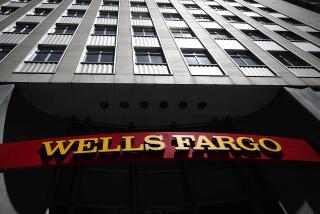Wells Fargo and Norwest to Merge in $32-Billion Deal
- Share via
Wells Fargo & Co., a California banking powerhouse for nearly 150 years, unveiled plans Monday to merge with Minneapolis-based Norwest Corp. in a $32-billion stock deal that will create the nation’s seventh-largest bank, with branches across 21 states in the West and Midwest.
While consumer activists immediately warned of higher fees and less personal service, which often come with such bank mega-mergers, they agreed this deal could be positive for California as the combined institution will be headquartered in San Francisco.
The merger could also make Wells Fargo a tougher competitor against rival BankAmerica Corp., the parent of Bank of America, which in April announced it would move its headquarters to Charlotte, N.C., from San Francisco as part of a $60-billion merger deal with NationsBank Corp.
Monday’s merger agreement will create the largest financial institution based west of the Mississippi, one that will be prominent in mortgage lending, online banking and small-business loans. The merged bank, with $191 billion in assets, will keep the Wells Fargo name, one of the oldest and best-known in banking.
Wells Fargo has about 1,100 employees at 75 locations in Orange County, at least a third of them in supermarket lobbies at Ralphs, Vons and Albertsons markets. The bank boosted its presence in the county early in 1996 when it acquired First Interstate Bank and its 34 Orange County offices.
“There couldn’t be a better brand. The stagecoach, the Wells name, it’s going to fit in well with our culture,” said Norwest Chief Executive Richard Kovacevich, who will be CEO and president of the combined company. Wells’ current CEO, Paul Hazen, who will become chairman, appeared at a New York news conference on Monday along with Kovacevich, both sporting ties with pictures of Wells Fargo’s founders.
Some industry analysts were cautious about the merger’s chance of success, as the deal joins Norwest, America’s largest mortgage lender and one of the top-performing banks this decade, with beleaguered Wells Fargo, which has seen its performance fade since its poorly executed $11.3-billion acquisition of First Interstate two years ago.
“People are kind of taking a show-me attitude with this deal,” said Thomas Theurkauf, an analyst with Keefe, Bruyette & Woods in New York. “It will take some time.”
The merger deal also brings together two banks with very different cultures, as Wells Fargo is known for its aggressive high-tech approach to banking and Norwest is known for its personalized, branch-oriented focus. As a result, some consumer activists said they hoped Wells would adopt what they called Norwest’s more “customer-friendly” strategy.
But Kovacevich said Norwest customers would benefit from Wells’ strengths in online banking and “alternative delivery systems, like supermarket branches,” while Wells Fargo customers would get a broader array of services, especially in mortgage lending and consumer finance, areas in which Norwest excels and Wells has little expertise.
Thus, although Norwest already makes or services a substantial number of mortgages in California, it expects to see dramatic growth once it begins to sell the products through Wells’ extensive branch system.
A possible acquisition of Wells has been rumored for months as a wave of consolidation has swept the financial services industry, creating such pending combinations as BankAmerica-NationsBank, Citicorp’s $72-billion merger with Travelers Corp. and First Chicago Corp.’s $30-billion deal with Banc One Corp. All hope to boost profits by capitalizing on cost savings achieved through size and an expanded customer base.
Cost savings in this deal are expected to be minimal initially, said analysts, as the only overlap between the two is in such Western states as Texas, Arizona and New Mexico. While details of branch closures and layoffs were not revealed, thousands of employees are expected to be affected either through relocation or eliminated positions, and some branches may be closed where the two overlap, analysts said.
“It’s a cobbling together of two financial powerhouses, but there’s not a lot of cost savings. It’s a strategic move,” said Charlotte Chamberlain, a bank analyst with Jefferies & Co. in Los Angeles. “The market is really taking this as a big ho-hum.”
Wells Fargo stock rose a slight $2.50 a share Monday to close at $365.75 in New York Stock Exchange trading, while Norwest fell $2.88 to close at $36.81, the first time this year that shares fell on word of a bank merger.
Wells shareholders are getting a slight 1% premium over Monday’s stock price close. Once the merger is completed, Wells investors will own 52.5% of the combined company, a financial giant with more than 90,000 employees, about 20 million customers and nearly 2,900 branches.
Analysts Knew Wells Was Ripe
The deal has been approved by the boards of both companies, but must also get approval from regulators and stockholders. While there is some overlap between the banks, there seemed to be few antitrust issues, analysts said. The deal is expected to close in four months.
Industry analysts had speculated that the recent wave of mergers in the financial industry would force Wells to find a merger partner or significantly improve earnings, which suffered dramatically because of computer problems and an exodus of customers after its takeover of First Interstate.
On Monday, even Wells chief Hazen admitted that his bank “tried to integrate the company [First Interstate] too fast,” and would not make the same mistake with this deal.
“We are very focused on making sure it happens smoothly without interruption to customer service,” said Norwest’s Kovacevich.
But consumer activists specifically warned customers Monday that this merger might bring many of the same computer glitches Wells had in absorbing First Interstate, when thousands of dollars of deposits were posted to the wrong accounts.
“We are urging Wells customers to watch their bank statements very carefully. People should be on guard for those same problems that occurred in the past,” said Jon Golinger, consumer program director for CalPIRG, a nonprofit consumer advocacy group in Sacramento.
Some consumers, such as Echo Park furniture store owner Neil Stone, whose local Wells Fargo branch closed in May, said they are worried about future service and community commitment.
The merger “means a lack of corporate concern for lower-income districts and inconveniences customers who have been loyal all these years,” Stone said.
However, some customers said Wells was improving.
“They’ve really made an effort to be more personable and give good service,” Elysian Heights businessman Philip Heath said outside the Atwater Village branch.
The mega-deal with Norwest took some by surprise, as Wells Fargo was rumored to be negotiating a combination with U.S. Bancorp of Minneapolis, a banking giant run by former Wells executive John F. Grundhofer, a longtime rival of Hazen.
There was speculation Monday that U.S. Bancorp had reportedly made a bid for Wells sometime in the past year, but neither company would confirm that. Reportedly, strategic issues scuttled that deal and made a combination with Norwest more attractive. When Wells’ board approved the Norwest merger Sunday, there was no other offer on the table, sources said.
The two CEOs, both seen as no-nonsense, straightforward leaders who have known each other for years, had discussed a possible merger several times in the past 12 months, sources said.
But this deal came together in just 10 days. It was hammered out quickly at the Doubletree Inn in Kansas City, where the two CEOs met one day last week, sources said. “White” was the code name for Wells and “Noble” the code name for Norwest, to correspond with each company’s initials, sources said.
In a rare move, both banks were advised by the same investment banking firm, Goldman, Sachs & Co. The firm, along with lawyers, will reportedly make $120 million in fees from the deal. CS First Boston Corp. later came in to advise Wells on the fairness of the deal at the end of negotiations. Although it’s rare for one bank to advise both companies, earlier this year Merrill Lynch & Co. advised two Italian banks on a deal.
While some speculated that U.S. Bancorp and Grundhofer may try to mount a hostile offer for Wells, most said it would be foolhardy because hostile bank mergers have not been very successful in the past.
“We’re joined at the hip and we’re going forward,” Kovacevich said Monday. Indeed, as part of the deal, each company was given an option to buy up to 19.9% of the other company on favorable terms, an arrangement made in some merger pacts to keep hostile suitors from breaking up the deal.
“That’s the $64,000 question--what will Grundhofer do now?” said bank analyst Chamberlain. “Will he go after something smaller like a City National or a Washington Mutual to get into California? We’ll just have to wait and see.”
A caretaker of a bit of the Old West’s identity, Wells was founded in 1852 by Henry Wells and William G. Fargo, co-founders of American Express Co., and provided a wide variety of services to pioneers.
*
Times correspondent Stephen Gregory contributed to this report.
Bank Rankings
The $32-billion merger between Wells Fargo & Co. and Norwest Corp. would create the nation’s seventh-largest bank:
*--*
Base Assets (in billions) 1. Citigroup New York $738.9 2. BankAmerica Corp. Charlotte, N.C. 579.9 3. Chase Manhattan Corp. New York 365.7 4. J.P. Morgan & Co. New York 271.5 5. Banc One Corp. Chicago 240.6 6. First Union Corp. Charlotte, N.C. 220.4 7. Wells Fargo & Co./Norwest Corp. San Francisco 190.9 8. Bankers Trust Corp. New York 157.5 9. Fleet Financial Group Boston 97.7 10. National City Corp. Cleveland 80.9
*--*
*as of March 31
Source: SNL Securities; Compiled by JENNIFER OLDHAM/Los Angeles Times
*
* ARE THEY A GOOD FIT?
A look at the challenges Wells Fargo, Norwest will face. D1
* BANKING’S FUTURE
With most of the big players merged, what’s next? D16
* MORE COVERAGE: D4
More to Read
Inside the business of entertainment
The Wide Shot brings you news, analysis and insights on everything from streaming wars to production — and what it all means for the future.
You may occasionally receive promotional content from the Los Angeles Times.










